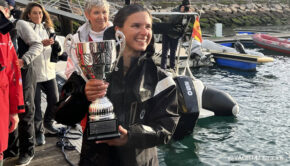Conditioning Secrets of the Offshore Soloist
Published on September 18th, 2018
As Alex Thomson is in the mdst of building a new IMOCA 60 for the 2020 Vendée Globe he will also need to focus on building up his conditioning This non-stop, three-month, 25,000-mile solo race around the globe is as extreme as racing gets – a true test of both physical and mental strength.
To finally claim the elusive victory in the Vendée Globe, Thomson’s fitness regime will play an essential role in enabling his ability to cope with the physical demands of the race. JOE, a British male-focused publication, checked in with Thomson to gain further insight into his regime.
What are the physical requirements of elite-level sailing?
Single-handed offshore racing is about as gruelling as sailing gets. When I race in the Vendée Globe – which happens just every four years and is the pinnacle of our sport – I am pushed to the limit both physically and mentally.
There are many different requirements on the physical side – you need to have the stamina to be able to keep working around the clock (there is no day and night in this race), the strength to be able to constantly move heavy items from one side of the boat to another, the balance and co-ordination to operate while sailing at high speeds and extreme angles.
You also need to be comfortable operating with very little sleep. During the last Vendée, the most I slept at any one time over the 75 days of the race was one hour. It is just relentless.
What particular attributes are most important?
Upper body strength is very important, especially when you consider that individual sails weigh up to 60 kilos.
But balance, mobility and flexibility are also important because, on the boat, I move around so much and I’m always changing levels, bending and kneeling. Even the simplest of tasks can be incredibly difficult, so balance and mobility are key.
How do you eat to fuel an ‘around the world’ sail?
There is no kitchen onboard the boat. Eating can become monotonous, but I have to make sure I consume enough calories every day in order to perform to the best of my ability.
In the Southern Ocean, for example, the conditions are so brutal that I need to consume around 7,000 calories a day just to be able to keep my energy levels where they need to be. I always joke that, as nice as it is to hear from friends, family and fans on social media during the race, the only thing I don’t want to hear about is what food they’re eating!
Alex’s trainer Lawrence Knott provides some specific details on the regime:
How do you go about planning/scheduling your training?
Alex has a really demanding schedule, particularly when he’s preparing to race, so we have to be as flexible as possible with his training.
Swimming is rotational and repetitive, which is very similar to the grinder on the boat (a device onboard the boat which is used to raise and trim the sails).
In swimming, the athlete is constantly rotating the arms and shoulders, and they need to be in a position to keep that rotation going for significant periods, so it’s a great form of exercise to do if you’re on the grinder for long periods like Alex is.
Do any other sports inform Alex’s training plan?
We also do a lot of cycling, both in the gym and on a mountain bike.
Again, this is rotational and it really works the legs, which is where Alex will carry the heavy loads that he lifts during races. We’ll also try to fit in some hill sprints because they cause the heart rate to rise significantly.
From there, it’s about how quickly you can recover. This is good because it allows us to build up Alex’s overall fitness, recovery times and lactic threshold.
Alex’s Strength and Conditioning Routine:
• Barbell Chest Press: 4 sets of 6 reps
• Leg Press: 4 sets of 8 reps
• Single Arm Bench Row: 4 sets of 6 reps
• Alternate Incline Dumbbell Press: 4 sets of 6 reps
• Drop Jumps [24-inch bodyweight]: 4 sets of 10 reps
• Barbell Curl into Overhead Press: 3 sets of 6 reps
• Low Cable Row: 3 sets of 6 reps
• Single-Leg Romanian Deadlifts: 3 sets of 8 reps on each leg
• Weighted Pull-Ups: 3 sets of 4 reps
Alex’s Conditioning Circuit:
Each station lasts for 45 seconds, with a 15 second rest in between exercises
• Press Ups (bodyweight)
• Step Ups: with an 8kg dumbbell in each hand
• Chin Ups (bodyweight)
• Left-Hand Dumbbell Raises: 15kg
• Walking Lunge: 20kg plate overhead
• TRX Rows (bodyweight)
• Right-Hand Dumbbell Raises: 15kg
• Medicine Ball Slams: 8kg
• Burpees
• Plank
Alex’s next race will see him compete in the ‘Route du Rhum’ in November – a 3510nm route that will take him from Saint Malo, France to Guadeloupe in the Caribbean.










 We’ll keep your information safe.
We’ll keep your information safe.